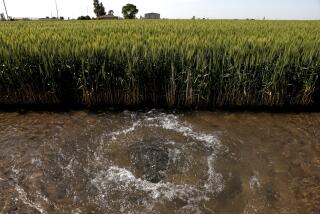New Water Rules Bring Penalties From Heaven : Drought: Districts throughout the county have collected hundreds of thousands of dollars from excessive users.
The city of Carlsbad has collected nearly $1 million in penalties from residents and businesses that have used more than their allotment of water over the past six months.
Now the City Council has the happy problem of deciding whether to give some of the money back to water-saving citizens, or perhaps keep the money for city projects.
And Carlsbad isn’t alone. Many other water agencies throughout San Diego County have had the same experience and are pondering similar solutions.
The Carlsbad council will discuss its unusual happenstance at its meeting tonight, where revisions to the city’s water rate structure are likely to occur.
The genesis of Carlsbad’s situation occurred in March, when the council imposed a 20% water savings edict on its customers and vowed to penalize everyone who used more than 80% of the amount they had used the year before--with a doubling of their water bill.
In August, the city refined the penalty, charging higher prices to those who used larger amounts over their quota.
The city accumulated more in penalties--$995,172--than any other water agency in the county.
Surprisingly, despite the number of water hogs and the large amount of penalty charges collected, Carlsbad met its 20% savings each month, and is due another $67,000 in incentive payments from the Metropolitan Water District for doing so.
It is a tale repeated at water districts all over the county.
Poway, the “City in the Country,” with many large residential lots, brought in $252,000 in customer penalties during its six-month conservation program and last month changed its system to give those with big lots a break, said Peggy Stewart, director of administrative services for the city.
Under the original program, water users were allowed 60 units (748 gallons per unit) for each two-month period, no matter what the size of their property.
Under the revision approved by the City Council on Sept. 17, Poway consumers no longer will be charged on the basis of the 60 units. Instead, they will be charged on the basis of how much water they actually use. Those who use more than 80% of the water they used a year before will be subject to fines.
Poway consumers who were penalized under the earlier set-usage system can expect rebate checks in the mail when city accountants refigure their earlier usage. The rebates will be paid out of the $252,000 in penalties collected, Stewart said.
Neighboring Escondido is also considering rebates to customers who paid penalties under the city’s 500-gallon-a-day usage schedule.
“We have been instructed by the council to explore the possibility of rebates to those who have saved 20% or more based on their historical usage but have been penalized under the present system,” said Cynthia Ferguson-Salvati, the city’s water reclamation and conservation administrator.
If there is anything remaining of the $252,000 after rebates have been made, it will probably go into a fund for use in paying future penalties to the MWD and to speed the city’s water reclamation program, Ferguson-Salvati said.
Del Mar, the county’s smallest city, has been tinkering with its water conservation program to tune in with its mostly residential users’ desires, and has assessed about $78,000 in penalties along the way.
Richard Andrews, public works director, said the excess funds are earmarked for paying out rebates in the city’s low-flow toilet installation program, in reprogramming the city’s computer and in paying for the additional cost of switching from a bimonthly to a monthly billing system.
Through August, Del Mar water users have used 32.6% less water than during the same period a year ago, Andrews said. The largest user, the state-owned fairgrounds and Del Mar Race Track, has cut its consumption 26% during the same period, he said.
Olivenhain Municipal Water District, which serves part of Encinitas and a large area of inland North County, has collected about $75,000 in penalties from over-users and plans to return the money to its water savers.
Ray Bischoff, finance officer for the district, said refunds to those who saved 20% or more will appear as credits on future water bills and will range from 23 cents to $32, based on the amount of conservation.
“This credit has been approved to convey a good-faith recognition for our constituency who have diligently worked to meet the required 20% reduction,” according to Ann Peay, vice president of the Olivenhain district’s board of directors. The board approved the rebate at a meeting Thursday.
The city of San Diego has a voluntary water conservation program, so no penalties of any kind are levied, explained water utilities spokesman Kurt Kidman.
Despite the lack of a penalty threat, city users have met the 20% goal of savings and, in fact, have exceeded it by 21,492 acre-feet of imported water, officials said. Savings have slipped below the 20% mark in recent weeks, however.
The savings are expected to bring the city nearly $1.4 million in incentive payments from the MWD.
Kidman said the San Diego City Council discussed imposing a penalty-reward system last month, but shelved the idea because of the excellent voluntary response of residents and businesses.
The Helix Water District, which serves much of the area east of the San Diego city limits, has collected about $544,000 in surcharges from its customers during the six months ending Sept. 30, administrative manager Don Kuhl said.
“Having a dirty car is a badge of honor in the district,” said Shirley Massey, district spokeswoman. “People have really tuned in to this thing. We’ve had water savings of 30% and more.”
Kuhl said that the district has revised its penalty schedules to allow customers to average their water use over four months, and that rebates will be given to those penalized when the earlier monthly use was high. Some of that $544,000 will be returned to the customers who can show that their four-month use was over the 20% savings mark, he said.
“There is no really fair way of doing this,” Massey said of the rationing system. “With experience, we are getting better at it.”
In the Otay Water District, a far-flung but sparsely populated area at the end of the imported-water pipeline, conservation measures have been a way of life for years, and actual cutbacks were imposed in 1988 “in preparation for the drought,” said district spokesman Charlie Cassens.
Under an incremental system designed to provide a method where “the more you use, the more it costs,” Otay has collected $116,457 in penalties, he said. The penalty funds are used partly to pay for the district’s conservation program, and the rest goes into district reserves for the day when the district itself must pay penalties to the MWD for drawing too much water from the aqueduct.
Customers countywide complained that the system appeared to be based on the theory that “the less you use, the more you pay” because bills kept increasing no matter how severe the water cutbacks were. Cassens explained that the reason for the escalating bills were two stiff water price increases imposed by the MWD.
However, not all water districts in the county fared as well.
Five of them--Fallbrook, Oceanside, Rainbow, Valley Center and Yuima (at the foot of Palomar Mountain)--were assessed penalties last spring at the onset of the water conservation program for failing to meet their goals.
Mark Stadler, public information specialist with the San Diego County Water Authority, said the penalties, assessed for last February and March, came mainly in heavy agricultural areas where growers combatted an unusually warm February with unusually heavy irrigation.
In Carlsbad, where the collection of penalties is the highest, council members will consider any and all of the changes instituted by other agencies, water district spokeswoman Jeanne Flack said.
For the $1 million in unbudgeted funds that the district has collected in penalties, city water officials propose a few more uses: a fund to stabilize rates in case of future MWD rate increases, development of new water sources and a more effective conservation program, among others.
“We do not think that the entire matter can be solved by the council in one night,” Flack said, “but we hope to get guidance from the council on which directions we should explore.”
More to Read
Sign up for Essential California
The most important California stories and recommendations in your inbox every morning.
You may occasionally receive promotional content from the Los Angeles Times.










